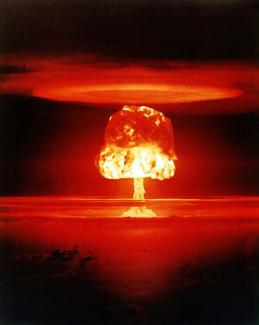After President Obama’s landmark visit to Hiroshima, we need concrete action on disarmament, argues Dr Philip Webber, SGR.
ResponsibleSci blog, 27 May 2016
Barack Obama has become the first sitting US President to visit Hiroshima and speak to the bomb survivors, the Hibakusha – for which I congratulate him. His speech was a clear appreciation of the scale of the problem the world faces due to nuclear weapons. Obama is quite right when he says, "mankind possesses the means to destroy itself". He is also correct about the proposed solution: "We must have the courage to escape the logic of fear and pursue a world without them." However, actions speak louder than words and regrettably there is an ongoing failure to make progress towards nuclear disarmament by all the nine nuclear armed states.
When President Obama came to power he spoke strongly in support of a "world free of nuclear weapons", and in particular of the 'Global Zero' proposals supported by very senior military and political figures across the world including in the US and Russia. These proposals recommended a whole range of actions to reduce the risk of global nuclear catastrophe by accident or systems failure, as well as a plan to achieve global nuclear disarmament. He was awarded the Nobel Peace Prize for his approach.
Regrettably, the US and Russia have made no real progress towards these goals to improve global security in the years since. Although the New Start Treaty was agreed between them in 2009, the numbers of nuclear weapons held by these two nations have only fallen slightly. Indeed, when he leaves Obama office there will still be about 15,000 nuclear weapons in the arsenals of nine nuclear states.
And in many ways things have got worse in recent years:
- We remain a few minutes from global catastrophe with 1,800 Russian and US warheads aimed at each other ready to launch at very short notice, and with aged equipment increasingly vulnerable to technical problems including cyber-attack.
- The US, Russia, China, the UK and France are all planning to spend enormous sums of money on “modernisation”, i.e. new nuclear weapons. The US planned spending on this modernisation is a staggering $1,000 billion over the next decade.
- Tensions between NATO and Russia have markedly increased – with actions by both sides contributing. NATO’s expansion eastwards close to Russia’s borders and the new deployment of a US anti-missile system in Romania are contributing to these tensions.
- Recent scientific research has revealed that the use of a very small fraction of current nuclear arsenals – for example only about 100 small nuclear weapons - would cause severe climate disruption leading to long-lasting crop failure and drought across much of the globe on top of the deaths of millions of people from the direct effects of these weapons.
World leaders, particularly those of nuclear-armed states, need to understand just how serious the threat is from the ongoing stockpiling, deployment and modernisation of nuclear weapons. We are much closer to nuclear annihilation than is widely appreciated. Radioactive fallout and climate disruption are no respecters of boundaries and treaties, and these impacts threaten every inhabitant of the Earth – even those far from targeted areas - and the very survival of humanity is at stake.
The level of risk is completely unacceptable and completely avoidable.
There are several exits away from "the logic of fear". One is for Obama to build on his visit to Hiroshima by calling for a new agreement with Russia to dramatically reduce the global nuclear threat and increase everyone’s security. He could call for the Global Zero recommendations to be rapidly implemented. He could also support multilateral nuclear disarmament discussions at the UN Open Ended Working Group (OEWG) and thus support a treaty to ban nuclear weapons of mass destruction in the same way as chemical and biological weapons.
Dr Philip Webber is Chair of Scientists for Global Responsibility, and author of numerous books and reports on nuclear weapons.
See also:
